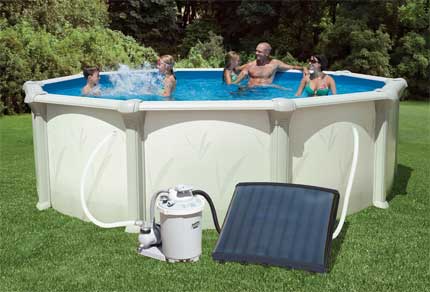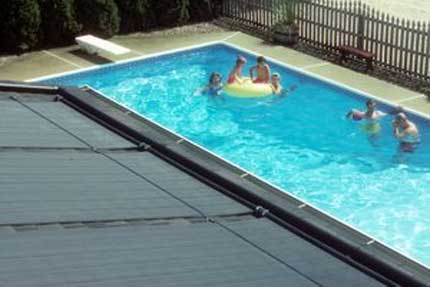Pool Heater Information & Sizing Guide
Pool heaters are the perfect solution for heating your pool water to the perfect temperature for you so that you can take advantage of cool days, evenings or nights when you normally wouldn’t swim. Also, in parts of the country, a pool heater can extend the swimming season beyond when you would normally be able to swim.
There are 3 main types of pool heaters to choose from, each with its own advantages and disadvantages:
- Natural Gas Pool Heaters
- Liquid Propane Pool Heaters
- Solar Pool Heaters
How Does A Pool Heater Work?
The function of a pool heater is really quite simple. When water is pumped out of your pool, it is run through your pool heater where the temperature is increased. When that warm water is pumped back into the pool, it increases the overal temperature of the pool water.
How Do You Size A Pool Heater?
Sizing a pool heater is not really as tricky as one might think. Pool heaters are rated in BTUs. So all we need to do is calculate the surface area of your pool, how many degrees you need to increase the temperature and we can determine how many BTUs you need from your pool heater.
1. Surface Area: The main job of any pool heater is to heat your pool’s water at a faster rate than heat is lost through the water surface exposed to the air. Typically, a solar pool cover is used in conjunction with any type of pool heater to maximize the efficiency and heating of the system.
As a rule of thumb, the more surface area your pool has, the more BTUs your pool heater will need to produce in order to heat the water faster than it cools. Calculations for finding the surface area of the most common shaped pools are listed below as a reference for you to use:
- Round Pool: radius x radius x 3.14 = surface area
- Rectangular Pool: length x width = surface area
- Oval Pool: 1/2 length x 1/2 width x 3.14 = surface area
- Kidney-Shaped Pool: length x width x 0.75 = surface area
2. Temperature Rise: Temperature rise is pretty simple. This is the difference between the desired pool water temperature and the average ambient air temperature. For example, if you would like your pool water to be 80 degrees and the average air temperature where you live is 60 degrees, then your desired temperature rise is 20 degrees. The equation below illustrates the equation:
- Desired water temperature – ambient air temperature = temperature rise
80 degrees – 60 degrees = 20 degrees
3. BTUs Required for Heating: Using the table below, you can take the surface area of your pool and the temperature rise desired in order to determine how many BTU you need your pool heater to produce each hour.
| Surface Area (ft2) | Temp Rise (F) | ||||
|---|---|---|---|---|---|
| 5F | 10F | 15F | 20F | 25F | |
| Required Heater Output (BTU/hr) | |||||
| 200 | 21,000 | 31,500 | 42,000 | 52,500 | 63,000 |
| 300 | 31,500 | 47,300 | 73,000 | 78,800 | 94,500 |
| 400 | 42,000 | 63,000 | 84,000 | 105,000 | 126,000 |
| 500 | 52,500 | 78,800 | 105,000 | 131,000 | 157,000 |
| 700 | 73,000 | 110,000 | 147,000 | 184,000 | 220,000 |
| 800 | 84,000 | 126,000 | 168,000 | 210,000 | 252,000 |
| 900 | 94,500 | 142,000 | 189,000 | 236,000 | 284,000 |
| 1000 | 105,000 | 157,000 | 210,000 | 263,000 | 315,000 |
4. Heater Efficiency: The efficiency of a pool heater is a measurement of how many of the BTUs that are input into the heater as fuel are converted and released as heat for your pool water. For instance, a heater rated at 300,000 BTU with an efficiency of 85% would produce 225,000 BTU/hr. The calculation is listed below:
- BTU input rating x efficiency = BTU/hr
300,000 BTU x 0.85 = 225,000 BTU/hr
Take the number of BTUs you need for your pool heater from the table above and find a pool heater whose BTU/hr exceeds that amount and you a pool that is the right size for your needs. It is generally best to err a little on the side of a pool heater that is too big rather than one that is too small.








Want To Save Money Running Your Pool This Year?
Check Out Our HydroJet Solar Pool Pumps